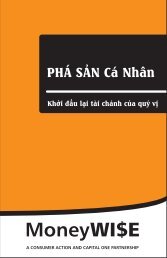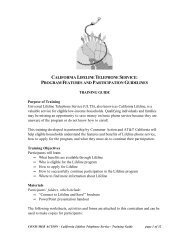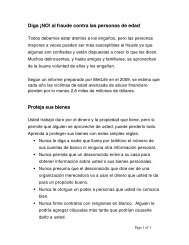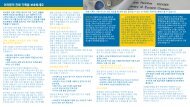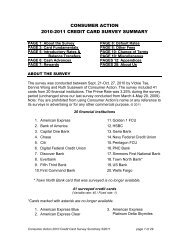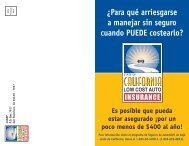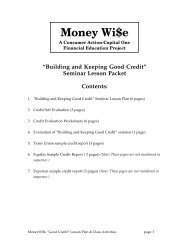Talking to Teens about Money - Seminar Lesson ... - Consumer Action
Talking to Teens about Money - Seminar Lesson ... - Consumer Action
Talking to Teens about Money - Seminar Lesson ... - Consumer Action
You also want an ePaper? Increase the reach of your titles
YUMPU automatically turns print PDFs into web optimized ePapers that Google loves.
<strong>Money</strong>Wi$eA <strong>Consumer</strong> <strong>Action</strong>-Capital OneFinancial Education Project<strong>Talking</strong> <strong>to</strong> <strong>Teens</strong> About <strong>Money</strong><strong>Seminar</strong> <strong>Lesson</strong> PlanMaterials Checklist1. <strong>Talking</strong> <strong>to</strong> <strong>Teens</strong> About <strong>Money</strong> (Booklet) 24 pages2. <strong>Lesson</strong> Plan and activity instructions for the two-part seminar (27 pages)3. “Needs Versus Wants” Exercise Worksheet (1 page)4. “Jamal’s First Paycheck” Exercise Worksheet (1 page)5. “Check Writing” Exercise Worksheet (1 page)6. “Checkbook Register” Exercise Worksheet (1 page)7. “Monica and Sarah” Exercise Worksheet (1 page)8. Weekly Spending Evaluation (This is for participants <strong>to</strong> use at home.) (1 page)9. <strong>Seminar</strong> Evaluation (To be completed in class and returned <strong>to</strong> instruc<strong>to</strong>r beforeleaving.) (1 page)© <strong>Consumer</strong> <strong>Action</strong> 2009
A <strong>Money</strong>Wi$e Training<strong>Talking</strong> <strong>to</strong> <strong>Teens</strong> About <strong>Money</strong><strong>Seminar</strong> <strong>Lesson</strong> Plan(For use by the <strong>Money</strong>Wi$e instruc<strong>to</strong>r)Course Purpose: To give parents <strong>to</strong>ols <strong>to</strong> help them talk <strong>to</strong> their teens <strong>about</strong>money.Course objectives:By the end of the training participants will understand:• The important role that parents play in helping their children build soundmoney management skills.• How parents can be strong role models.• How <strong>to</strong> help kids understand the difference between “needs” and “wants.”• How you can save money by comparison shopping.• How <strong>to</strong> find the best bank accounts for your teens.• Ways <strong>to</strong> avoid trouble with credit cards.• Saving money on teen driving costs.Materials:Participant’s folder, which includes:• <strong>Talking</strong> <strong>to</strong> <strong>Teens</strong> About <strong>Money</strong> (booklet)• Exercise worksheets (attached at the end of this lesson plan):I. “Needs Versus Wants”II. “Jamal’s First Paycheck”III. “Check Writing”IV. “Check Register”V. “Monica and Sarah”VI. Weekly Spending Evaluation Take-Home Worksheet• Evaluation of the <strong>Money</strong>Wi$e Banking Basics <strong>Seminar</strong>For trainer:• <strong>Seminar</strong> <strong>Lesson</strong> Plan• <strong>Talking</strong> <strong>to</strong> <strong>Teens</strong> About <strong>Money</strong> (booklet)• “<strong>Teens</strong> & <strong>Money</strong>” PowerPoint presentation with notes. (You can also use this <strong>to</strong>create handouts for the class.)• Easel, pad and markers<strong>Seminar</strong> Duration: There will be two sessions of two hours each. Each two-hoursession will include a 15-minute break.“<strong>Talking</strong> <strong>to</strong> <strong>Teens</strong> About <strong>Money</strong>” — <strong>Money</strong>Wi$e <strong>Lesson</strong> Plan Page 2 of 27
A <strong>Money</strong>Wi$e TrainingTraining OutlineFirst Session(Two Hours)Suggested Time Allotment:Topic:10 mins. Welcome and Training Overview10 mins. Group Introductions5 mins. <strong>Teens</strong> and <strong>Money</strong> (Needs/Wants Exercise)10 mins The Working Life15 mins “Jamal’s First Paycheck” (Exercise)15 mins. Break15 mins. Budgeting10 mins. Comparison Shopping15 mins Banking for Young People10 mins. Writing Checks (Check Writing Exercise)5 mins. First Session Wrap-UpTotal: 120 mins.Second Session(Two Hours)Suggested Time Allotment:Topic:5 mins. Welcome participants back15 mins. Balancing a Checkbook (Check Register Exercise)10 mins. Saving15 mins “Monica & Sarah” (Exercise)10 mins. Credit His<strong>to</strong>ries and Credit Reports15 mins. Break10 mins. Credit Cards10 mins. Teen Drivers10 mins. Cell Phones15 mins. Questions and Answers5 mins. Wrap-up and EvaluationTotal: 120 mins.“<strong>Talking</strong> <strong>to</strong> <strong>Teens</strong> About <strong>Money</strong>” — <strong>Money</strong>Wi$e <strong>Lesson</strong> Plan Page 3 of 27
A <strong>Money</strong>Wi$e TrainingTraining Design/<strong>Lesson</strong> PlanSession One (Two Hours)(Note: Before conducting the training, familiarize yourself with this lesson plan, the<strong>Talking</strong> <strong>to</strong> <strong>Teens</strong> About <strong>Money</strong> booklet and PowerPoint presentation.)Suggested Time Allotment: Topic:10 mins. Welcome and Training Overview10 mins. Group Introductions5 mins. <strong>Teens</strong> and <strong>Money</strong> (Needs/Wants Exercise)10 mins The Working Life15 mins “Jamal’s First Paycheck” (Exercise)15 mins. Break15 mins. Budgeting10 mins. Comparison Shopping15 mins Banking for Youths10 mins. Writing Checks (Check Writing Exercise)5 mins. First Session Wrap-UpTotal: 120 mins.Welcome participants. Hand out folders.Welcome and Training Overview(10 mins.)Review the knowledge and skills that the participants can expect <strong>to</strong> gain, including:• How <strong>to</strong> help young people build sound money management skills.• How <strong>to</strong> be a strong role model.• How <strong>to</strong> help kids understand the difference between “needs” and “wants.”• How you can save money by comparison shopping.• How <strong>to</strong> find the best bank accounts for your teens.• Ways <strong>to</strong> avoid trouble with credit cards.• Saving money for teen drivers.Review the day’s agenda, emphasizing that the <strong>to</strong>pics will be broken down in<strong>to</strong> short,easily digestible sections of 5-15 minutes apiece and that there will be a 15-minute break<strong>about</strong> halfway through the session.Group Introductions(10 mins.)Ask participants <strong>to</strong> introduce themselves and say what they hope <strong>to</strong> get out ofthe seminar.“<strong>Talking</strong> <strong>to</strong> <strong>Teens</strong> About <strong>Money</strong>” — <strong>Money</strong>Wi$e <strong>Lesson</strong> Plan Page 4 of 27
A <strong>Money</strong>Wi$e TrainingWrite down participants’ expectations on the easel pad. (This activity will serveas a brief icebreaker <strong>to</strong> help workshop participants get <strong>to</strong> know each other and feel morecomfortable, and <strong>to</strong> give you an idea of what participants are expecting from the seminar.Save the page for the final wrap-up and evaluation at the end of the second session, sothat you can revisit it and ask for feedback on how participants feel <strong>about</strong> the seminar.)RESOURCE: Direct attention <strong>to</strong> the “<strong>Talking</strong> <strong>to</strong> <strong>Teens</strong> About <strong>Money</strong>” booklet inparticipants’ folders. Give the class a few minutes <strong>to</strong> review the brochure beforeyou continue.<strong>Teens</strong> and <strong>Money</strong> (With Needs/Wants Exercise)(5 mins.)Ask participants what they learned from their own parents, or other adultmen<strong>to</strong>rs, <strong>about</strong> managing money. Write down some responses on the easel pad.Suggested remarks:• Parents play a key role in shaping values and attitudes <strong>about</strong> moneymanagement.• Children who receive information <strong>about</strong> money management at home are morefinancially literate than those who are only taught money skills in school.• <strong>Teens</strong> are under tremendous pressure <strong>to</strong> conform <strong>to</strong> their peers.• Only a strong role model can counteract teen peer pressure.• Kids <strong>to</strong>day have considerable disposable income—and they are a target foradvertisers and marketers.Questions <strong>to</strong> generate discussion:• Why do you think it is important <strong>to</strong> provide teens with strong adult role models?—To help teens build self-esteem and confidence.—To counteract teen peer pressure.—To counteract the pressure of advertising and marketing that urges kids <strong>to</strong>spend money on “wants” instead of “needs.”• What are some family activities that you don’t have <strong>to</strong> spend much money on?—Sports, cookouts, hikes, bike rides, museums, free events such as concerts andplays, listening <strong>to</strong> books on tape or watching movies from the library, preparingfood.• Should kids be given every material thing they desire?—Everyone must set priorities for what they want.—Basic needs (food, clothing, shelter, education and transportation) takepriority.—Overspending is an addiction that can lead <strong>to</strong> debt and even bankruptcy.“<strong>Talking</strong> <strong>to</strong> <strong>Teens</strong> About <strong>Money</strong>” — <strong>Money</strong>Wi$e <strong>Lesson</strong> Plan Page 5 of 27
A <strong>Money</strong>Wi$e TrainingNeeds/Wants Exercise:Ask participants <strong>to</strong> take out the activity sheet from their folders. Stress that thisis not a test, but a learning activity.Instructions:As shown in the “fast food lunch” example on the worksheet• write your opinion on whether the items listed are needs or wants;• give a short reason why you feel that way;• assign a price <strong>to</strong> the item, and• suggest an alternative.Allow participants <strong>about</strong> 10 minutes for the activity. Then ask for everyone’sattention. Go over each item with the class, asking for volunteers <strong>to</strong> give differentanswers <strong>to</strong> the questions. Validate participants’ ideas with positive statementssuch as, “That’s a great point!” Encourage participants <strong>to</strong> speak by saying, “Doesanyone have any other ideas?”Question <strong>to</strong> generate discussion:• Do you think teenagers know the difference between needs and wants?The Working Life(10 mins.)(See “<strong>Talking</strong> <strong>to</strong> <strong>Teens</strong> About <strong>Money</strong>” booklet, page 2.)Suggested remarks:• Having a job helps kids prepare for adult life.• Work habits formed as a teenager follow you for the rest of your life.• Teaching financial responsibility can be difficult if kids don’t know what it’slike <strong>to</strong> earn their own money.Key points <strong>about</strong> teen jobs:• <strong>Teens</strong> 16 and older generally can work full time, although some states maylimit the times of day they can work.• <strong>Teens</strong> aged 14 and 15 can work 18 hours a week but no more than three hourson school days. In the summer, they can work eight hours a day, 40 hours aweek.• Younger teens can do odd jobs such as running errands, babysitting, dogwalking or lawn mowing.Questions <strong>to</strong> generate discussion:• What skills did you gain from your first job?—People skills—Office or computer skills“<strong>Talking</strong> <strong>to</strong> <strong>Teens</strong> About <strong>Money</strong>” — <strong>Money</strong>Wi$e <strong>Lesson</strong> Plan Page 6 of 27
A <strong>Money</strong>Wi$e Training—How <strong>to</strong> handle money—How <strong>to</strong> please my boss—That it’s nice <strong>to</strong> have my own money• What are some ways you can help teens initiate a job search?—Help them write their resumes—Suggest that they gather job applications from local businesses—Search the classified ads <strong>to</strong>gether—Rehearse a call <strong>to</strong> an employer or a job interview—Try some online job searches <strong>to</strong>gether• What are some of the most important things <strong>to</strong> tell teens <strong>about</strong> working?—The early bird gets the worm—or in this case the job.—Neat attire and being on time are important in the work place.—Pay attention and ask questions if you don’t understand.—Persistence and being a “self starter” are traits valued by many employers.—Working should not be drudgery—find something you like <strong>to</strong> do and canbecome good at.Jamal’s First Paycheck (Exercise)(15 mins.)Ask participants <strong>to</strong> take out the activity sheet from their folders. Stress that thisis not a test, but a learning activity.Go over the instructions:Jamal just started <strong>to</strong> work as a part-time salesperson at a local computer s<strong>to</strong>re. Hispaycheck is smaller than he expected it <strong>to</strong> be. When he reads his pay stub, he is surprised<strong>to</strong> see that deductions have been taken from his paycheck. Study Jamal’s paycheck andanswer the questions at the bot<strong>to</strong>m of the page.Go over these key points before asking participants <strong>to</strong> start the exercise:• The paycheck stub is part of Jamal’s paycheck. The stub lists Jamal’s hourlywage, how many hours he worked in the current pay period and any paycheckdeductions that were withheld from his paycheck.• Deductions are money that is subtracted or deducted from the <strong>to</strong>tal wages due<strong>to</strong> workers.• Many employees are eligible for health insurance or a retirement plan. Theseare called job benefits. New employees or part-time employees are not alwayseligible for benefits.• In most cases, employees must pay some portion of their health insurance ormake certain contributions <strong>to</strong> the retirement plan that will then be matched bythe employer. In this case, the employees’ portion would be deducted from theirpaychecks.Ask participants <strong>to</strong> take five minutes <strong>to</strong> study Jamal’s paycheck and answer thequestions at the bot<strong>to</strong>m of the page. After 5 minutes, discuss the answers <strong>to</strong> thequestions <strong>to</strong>gether as a group:“<strong>Talking</strong> <strong>to</strong> <strong>Teens</strong> About <strong>Money</strong>” — <strong>Money</strong>Wi$e <strong>Lesson</strong> Plan Page 7 of 27
A <strong>Money</strong>Wi$e Training• What is the pay period at Dynamite Computer Supers<strong>to</strong>re?—The pay period is from Sept. 15-30, so the pay period for Jamal’s employer issemi-monthly, or two times per month.• Why are Jamal’s current <strong>to</strong>tal deductions the same amount as his year-<strong>to</strong>-datedeductions?—As stated in the introduction <strong>to</strong> the activity, Jamal just started the job, so he hasno payroll his<strong>to</strong>ry for the year.• What amount has been withheld from Jamal’s paycheck for his federal income taxwithholding?—The answer is $22.91.• Does “gross” pay mean before taxes or after taxes?—Gross pay means before taxes. Because Jamal’s “gross pay” as shown on hispay stub is larger than his “net pay,” you can conclude that gross means beforetaxes.• What is the <strong>to</strong>tal amount taken from Jamal’s paycheck for the Federal InsuranceContribution Act (FICA) which includes Social Security and Medicare deductions?—$22.18. To get the answer, add Medicare ($17.98) and Social Security ($4.20)withholding.• Why do you think that no deductions are taken from Jamal’s paycheck for medicalinsurance and retirement?—Jamal, as a new employee, probably is not eligible for these benefits.Announce a 15-minute break.Break(15 mins.)Budgeting(15 mins.)(See “<strong>Talking</strong> <strong>to</strong> <strong>Teens</strong> About <strong>Money</strong>” booklet, pages 4-5.)Suggested remarks:• A budget is a spending plan <strong>to</strong> help you forecast and control your expenses.• <strong>Teens</strong> can be impulsive and a budget can help them step back and see wheretheir money goes.• Most people just can’t go out and buy the things they want without someplanning.• By watching what you spend and carefully allocating your money, you cansave money <strong>to</strong> buy things you want but can’t afford at the moment.Questions <strong>to</strong> generate discussion:• What are some ways you can track your spending?“<strong>Talking</strong> <strong>to</strong> <strong>Teens</strong> About <strong>Money</strong>” — <strong>Money</strong>Wi$e <strong>Lesson</strong> Plan Page 8 of 27
A <strong>Money</strong>Wi$e Training—Keep cash receipts and bills in an envelope.—Make a file on your computer.—Use your checkbook register.—Moni<strong>to</strong>r your bank statements.• What value can you gain from keeping a budget?—See where your money goes.—See how much you can spend each month.—Allocate some money <strong>to</strong> savings.Let participants know there is a take-home worksheet in their folders that can beused <strong>to</strong> track weekly expenses. They can use the worksheet <strong>to</strong> explain budgeting<strong>to</strong> family members, or use it themselves.Comparison Shopping(10 mins.)(See “<strong>Talking</strong> <strong>to</strong> <strong>Teens</strong> About <strong>Money</strong>” booklet, page 8.)Key points:• Comparison shopping means that you “shop around” in person, by phone oron the Internet, <strong>to</strong> compare prices in order <strong>to</strong> find the best deal.• Comparison shopping can have a big payoff for just a small amount of work.• The Internet can be helpful in comparing prices. Even if you don’t purchase theitem you are interested in online, you will be armed with information that canhelp you make informed buying decisions.• Compare new and used goods if appropriate.• Ask your kids <strong>to</strong> come with you <strong>to</strong> your favorite supers<strong>to</strong>re—it’s a great chance<strong>to</strong> show them how <strong>to</strong> comparison shop.Questions <strong>to</strong> generate discussion:• Do you think that the s<strong>to</strong>re brand version of a must-have item is better or worse thanthe brand name version?—S<strong>to</strong>re brands are often made by the same brand-name manufacturer thatadvertises on national TV, but they may cost much less.• What is a good reason <strong>to</strong> consider buying second-hand or used items?—In many cases, used items such as furniture or au<strong>to</strong>mobiles often are betterquality than new goods at a comparable price.—Retro and vintage stuff are “in.”Banking for Youths(15 mins.)(See “<strong>Talking</strong> <strong>to</strong> <strong>Teens</strong> About <strong>Money</strong>” booklet, pages 9-11.)One of the most important lessons for teens is learning how <strong>to</strong> handle a bankaccount properly. As an alternative <strong>to</strong> a bank account, your children may be able<strong>to</strong> open an account at a local credit union.“<strong>Talking</strong> <strong>to</strong> <strong>Teens</strong> About <strong>Money</strong>” — <strong>Money</strong>Wi$e <strong>Lesson</strong> Plan Page 9 of 27
A <strong>Money</strong>Wi$e TrainingHere are some important points <strong>about</strong> credit unions:• A credit union is a non-profit cooperative financial institution owned andcontrolled by its members, while a bank is a for-profit company that makesmoney from charging fees and lending money.• Credit unions serve groups that share something in common, such as theirprofession, place of worship or neighborhood.• Credit unions provide checking and savings accounts and loans, often at betterrates than commercial banks.TIP: To find a credit union that you can join, call the Credit Union NationalAssociation at 800-358-5710, or visit its web site (www.cuna.org).The advantages <strong>to</strong> having a bank or credit union account:• Your money is safe from loss, theft or fire.• Each account is insured up <strong>to</strong> $100,000 by the Federal Deposit InsuranceCorporation (banks) or the National Credit Union Share Insurance Fund (creditunions).• Canceled checks are proof that you paid a bill.• Using check-cashing s<strong>to</strong>res and money orders is more expensive than payingbank fees.• A bank account can help you keep track of how you spend your money.Key points <strong>about</strong> checking accounts for youth:• Checking and savings accounts are great ways <strong>to</strong> help young people learn <strong>to</strong>manage money.• By teaching your kids <strong>to</strong> manage a checking account, you can also pave theway <strong>to</strong> good financial habits such as careful money management, paying bills ontime and handling credit cards well.• A bank account—savings or checking—is handy for cashing paychecks.• Writing checks is a safe alternative <strong>to</strong> carrying cash.• An ATM or debit card, which comes with many checking accounts, can serveas “training wheels” for using credit cards.• Most youth accounts are “cus<strong>to</strong>dial”—an adult must open the account onbehalf of the minor and the adult is responsible for the account.Questions <strong>to</strong> generate discussion:• What should you look for when comparing accounts?—Look for “free” youth accounts with no minimum balance requirement ormonthly service fees and unlimited check writing with no per-check fees.—Special accounts for youth usually require a low minimum balance ($1 <strong>to</strong> $5).—Some banks offer a slightly higher interest rate for youth accounts.• What are some ways <strong>to</strong> help your teen find a bank account?—In many communities there are banks and credit unions offering specialaccounts for young people.—Suggest that your teenager call some banks listed in the Yellow Pages andcompare accounts they offer, or compare accounts online.“<strong>Talking</strong> <strong>to</strong> <strong>Teens</strong> About <strong>Money</strong>” — <strong>Money</strong>Wi$e <strong>Lesson</strong> Plan Page 10 of 27
A <strong>Money</strong>Wi$e TrainingTIP: Bankrate.com (www.bankrate.com) allows you <strong>to</strong> find and comparechecking and savings accounts by ZIP code or city.• What are some things <strong>to</strong> avoid when looking for a checking account for your teen?—Avoid accounts with fees, service charges and minimum balance requirementsthat quickly eat up deposits.• What should you bring with you when you go with your teen <strong>to</strong> open a bank account?—When you and your teen go <strong>to</strong> open a bank account, you’ll both need <strong>to</strong> bringpho<strong>to</strong> identification (driver’s license or state identification card) and your SocialSecurity numbers.Writing Checks (With Check Writing Exercise)(10 mins.)(See “<strong>Talking</strong> <strong>to</strong> <strong>Teens</strong> About <strong>Money</strong>” booklet, page 11.)Important check-writing tips:• Make sure you have enough money in the bank <strong>to</strong> cover the check.• Review your bank statement promptly.• Record all the checks you write in your checkbook register or use duplicatechecks that create a carbon copy of each check.• Deposit paychecks and other checks in a timely manner—most checks cannotbe cashed after three months.• Use a pen—never a pencil—<strong>to</strong> write checks.• Write your checks legibly—scribbling can cause problems when the check iscashed.• Fill in the check amount and payee well <strong>to</strong> the left <strong>to</strong> prevent someone fromadding numbers <strong>to</strong> make the check larger or altering the payee’s name.• If you need <strong>to</strong> correct a mistake on a check, tear up the check, enter it as “void”in your checkbook register and write a new check.• Don’t sign blank checks—they can be s<strong>to</strong>len or used by someone else.• Know where your checkbook is at all times and report a missing checkbook <strong>to</strong>your bank immediately.Check writing activity:Pass out copies of the activity <strong>to</strong> participants. Go over the directions:This check belongs <strong>to</strong> Cody Sampson, who buys a CD using one of his checks. Fill out thecheck according <strong>to</strong> these instructions, enter the check in Cody’s checkbook register andfigure the current balance. (Answer: $476.89)Classroom discussion question:• Why is it important <strong>to</strong> enter the checks you write in your checkbook register?—So that you don’t bounce checks.—So that you know how much money you have in the bank.—So that you can track your spending and stick <strong>to</strong> a budget.“<strong>Talking</strong> <strong>to</strong> <strong>Teens</strong> About <strong>Money</strong>” — <strong>Money</strong>Wi$e <strong>Lesson</strong> Plan Page 11 of 27
A <strong>Money</strong>Wi$e TrainingFirst Session Wrap-Up(5 mins.)Thank the class for its attention and participation.Quickly review the <strong>to</strong>pics that will be covered in the upcoming <strong>Money</strong>Wi$esession (balancing a checkbook, saving, credit reports, credit cards, teen driversand cell phones).Let participants know that there will be a question-and-answer session. If they havequestions <strong>about</strong> <strong>to</strong>day’s session, suggest that they make a note and keep it in their folder.Point out the “Weekly Spending Evaluation” worksheet in their folders. Explainthat this worksheet is for them <strong>to</strong> take home for themselves and family members<strong>to</strong> use <strong>to</strong> track spending.Ask participants <strong>to</strong> read the “<strong>Talking</strong> <strong>to</strong> <strong>Teens</strong> About <strong>Money</strong>” booklet before thenext session.“<strong>Talking</strong> <strong>to</strong> <strong>Teens</strong> About <strong>Money</strong>” — <strong>Money</strong>Wi$e <strong>Lesson</strong> Plan Page 12 of 27
A <strong>Money</strong>Wi$e TrainingSession Two (Two Hours)Suggested Time Allotment: Segment:5 mins. Welcome participants back15 mins. Balancing a Checkbook (Check RegisterExercise)10 mins. Saving15 mins “Monica & Sarah” (Exercise)10 mins. Credit His<strong>to</strong>ries and Credit Reports15 mins. Break10 mins. Credit Cards10 mins. Teen Drivers10 mins. Cell Phones15 mins. Questions and Answers5 mins. Wrap-up and EvaluationTotal: 120 mins.Welcome (5 mins.)Greet participants and welcome them back. (This time will allow the group <strong>to</strong>reconnect with each other and with you.)Balancing A Checkbook(15 mins.)(See “<strong>Talking</strong> <strong>to</strong> <strong>Teens</strong> About <strong>Money</strong>” booklet, page 12.)Suggested remarks:• One of the most important financial lessons is how <strong>to</strong> balance a checkbook.• If you fail <strong>to</strong> keep an accurate record, you could bounce a check.• Bounced check fees from your bank can be up <strong>to</strong> $35 per check.• Most s<strong>to</strong>res also charge an additional penalty of up <strong>to</strong> $30 <strong>to</strong> cus<strong>to</strong>mers whosechecks are returned for lack of funds.Check Register Exercise:Ask participants <strong>to</strong> take the Check Register Exercise worksheet out of theirfolders. (Stress that this is not a test, but a learning exercise.) Ask them <strong>to</strong> reviewthe entries and answer the questions below. Give them 5 minutes <strong>to</strong> answer thequestions. Ask for volunteers <strong>to</strong> answer each question.1. What was the balance on July 13?—Since no new transactions were recorded between July 12 and July 13, thebalance on July 13 is $246.76.2. How many CDs did you purchase using a check in June?—One CD was purchased using a check in June, on June 10.“<strong>Talking</strong> <strong>to</strong> <strong>Teens</strong> About <strong>Money</strong>” — <strong>Money</strong>Wi$e <strong>Lesson</strong> Plan Page 13 of 27
A <strong>Money</strong>Wi$e Training3. How many checks did you write in July?—No checks were written in July.4. What’s your balance after you wrote a check <strong>to</strong> Music Megas<strong>to</strong>re on Aug. 6?—After deducting Check No. 103 written <strong>to</strong> Music Megas<strong>to</strong>re for $16.98 from theprevious balance of $511.22, the new balance is $494.24.5. How often did you use your debit card <strong>to</strong> make purchases in July?—Three times. The debit card was used <strong>to</strong> make purchases on July 5, 18 and 28.Saving(10 mins.)(See “<strong>Talking</strong> <strong>to</strong> <strong>Teens</strong> About <strong>Money</strong>” booklet, page 14.)Suggested remarks:• Because <strong>to</strong>day’s savings interest rates are so low, it’s <strong>to</strong>ugh <strong>to</strong> get kidsinterested in the power of savings.• Instead, concentrate on how important it is <strong>to</strong> make regular deposits <strong>to</strong> yoursavings account so that you have a cushion <strong>to</strong> fall back on if you need it.Here are some examples <strong>to</strong> give:• Even at interest rates of 1%-2%, saving just $20 per month can build more than$10,000 over a 30-year period.• If a 14-year-old begins <strong>to</strong> deposit $20 in babysitting earnings every week in asavings account that pays 1%-2% interest, by the time she enters college theaccount should be worth <strong>about</strong> $5,400.• If the same teen deposited only $20 per month for the same period, the accountwould be worth only <strong>about</strong> $1,250.Question <strong>to</strong> stimulate discussion:• Why is it important <strong>to</strong> make frequent, regular deposits <strong>to</strong> a saving account?—While money will grow even if left alone in an interest bearing account, thecombination of interest and regular deposits <strong>to</strong> a savings account is the way <strong>to</strong>build a large nest egg over a few years—or even a lifetime.TIP: Just type “savings calcula<strong>to</strong>r” in<strong>to</strong> an Internet search engine and you comeup with dozens of easy-<strong>to</strong>-use <strong>to</strong>ols. (If you don’t have Internet access at home,visit your nearest public library.) Plug in potential deposits, a realistic interestrate and years <strong>to</strong> maturity, and you’ll learn how regular deposits in<strong>to</strong> a savingsaccount can help your money grow.“Monica & Sarah”(Exercise) (15 mins.)Ask participants <strong>to</strong> take out the activity sheet from their folders. Stress that this isnot a test, but a learning activity.Go over the instructions:“<strong>Talking</strong> <strong>to</strong> <strong>Teens</strong> About <strong>Money</strong>” — <strong>Money</strong>Wi$e <strong>Lesson</strong> Plan Page 14 of 27
A <strong>Money</strong>Wi$e TrainingMonica and Sarah both work as salespeople after school and on weekends. Bothyoung women take home $294 every two weeks. Below are the financialtransactions made by Monica and Sarah in the past week. Review the girls’spending and answer the questions below.Allow participants <strong>about</strong> 10 minutes for the activity. Then ask for everyone’sattention. Go over the questions with the class, asking for volunteers <strong>to</strong> givesome different answers <strong>to</strong> the questions. Encourage participants <strong>to</strong> speak bysaying, “Does anyone have any other ideas?”• What are some differences between the young women’s spending habits?—Monica is a big spender. She doesn’t seem <strong>to</strong> save any of her salary.—Sarah is very careful with her money. She buys food from a market instead ofeating at fast-food restaurants.—Sarah puts a large proportion of her salary in a savings account.• Does anything either of the girls bought seem like an extravagance?—Monica’s three pairs of new shoes stand out.• Can you think of some ways that Monica could start saving more of her earnings?—Monica could prepare a brown bag lunch or dinner instead of buying fastfood.—Monica could exchange magazines with her friends so she doesn’t have <strong>to</strong> buyher own copies.—Monica could buy clothes where she works <strong>to</strong> take advantage of the employeediscount.Credit His<strong>to</strong>ries and Credit Reports(10 mins.)(See “<strong>Talking</strong> <strong>to</strong> <strong>Teens</strong> About <strong>Money</strong>” booklet, page 17.)Suggested remarks:• Graduating college with bad credit impacts more than just the ability <strong>to</strong> getloans or credit cards.• Bad credit shows up on your “credit report”—information <strong>about</strong> your past useof credit compiled by companies called credit reporting bureaus.• Credit reports are increasingly used by employers <strong>to</strong> screen applicants.• In certain fields—like financial services, technology and law enforcement—credit checks for job applicants are the norm.• No matter how good your grade point average was, or which degrees you’veearned, bad credit can cost you the job.• Failure <strong>to</strong> manage their first credit card accounts has caused many students <strong>to</strong>endure years of damaged credit and even bankruptcy.• People with bad credit usually have <strong>to</strong> put down cash deposits in order <strong>to</strong> getphone and utility service, which can add <strong>to</strong> the cost of getting your ownapartment.“<strong>Talking</strong> <strong>to</strong> <strong>Teens</strong> About <strong>Money</strong>” — <strong>Money</strong>Wi$e <strong>Lesson</strong> Plan Page 15 of 27
A <strong>Money</strong>Wi$e TrainingQuestions <strong>to</strong> generate discussion:• Do even young people have credit reports?—Everyone who has had a credit card or a loan will have a credit report. Butsince most young people do not acquire a credit card until they are 18, only asmall number of younger teens have credit files.• Do you have a right <strong>to</strong> know what is in your credit report?—Federal law gives you the right <strong>to</strong> find out what’s in your file.—Each year, you may request a free report from each of the three major creditreporting companies. To get your free copies, go <strong>to</strong> the Annual Credit Reportweb site (www.annualcreditreport.com) or call 877-322-8228. On the web site,you can apply online and get your report immediately or download an orderform and send it in by mail.• Which companies compile credit reports?—There are three major national credit reporting bureaus that provide “creditreports” <strong>to</strong> lenders and other businesses:• Equifax: 800-685-1111, www.equifax.com• Experian: 888-397-3742, www.experian.com• TransUnion: 800-888-4213, www.transunion.com—There are many other companies that provide “specialty credit reports” forphones, insurance, rentals, etc.• Are there other situations in which you can get a free credit report?—People who are turned down for credit, insurance, a rental, or a job because ofinformation on their credit reports can get a free copy of their credit report fromthe company that supplied the information. Upon request, the company thatdenied you must supply contact information for the credit reporting bureau. Therequest must be made within 60 days.Announce a 15-minute break.Break(15 mins.)Credit Cards(10 mins.)(See “<strong>Talking</strong> <strong>to</strong> <strong>Teens</strong> About <strong>Money</strong>” booklet, page 15-16.)Key points:• Many parents allow their children <strong>to</strong> get a credit card so that they will haveaccess <strong>to</strong> emergency funds.• If moni<strong>to</strong>red carefully, credit cards can be helpful in teaching your childrenhow <strong>to</strong> manage money.• Close <strong>to</strong> two-thirds of college students have at least one credit card.Questions <strong>to</strong> generate discussion:“<strong>Talking</strong> <strong>to</strong> <strong>Teens</strong> About <strong>Money</strong>” — <strong>Money</strong>Wi$e <strong>Lesson</strong> Plan Page 16 of 27
A <strong>Money</strong>Wi$e Training• Is it a good idea for young people of college age <strong>to</strong> have a credit card?—Yes, it’s probably a good idea because it can help them build a credit his<strong>to</strong>ry.—Young people who have shown that they are financially responsible byworking and saving their money may be more worthy of trust than kids whospend every penny on things they want but don’t need.• Can you think of any ways <strong>to</strong> control a student’s use of credit cards?—Ask them <strong>to</strong> give you the account number <strong>to</strong> keep tabs on the account so thatyou can head off any trouble.—Make them an authorized user on your own credit card. In most cases this willstill help them build a credit his<strong>to</strong>ry.• Why do you think credit card companies are so willing <strong>to</strong> give credit cards <strong>to</strong> four-yearcollege students?—The companies may believe that parents will bail out their kids if they get infinancial trouble.—Card companies know that free t-shirts, backpacks and other incentives makeit easy <strong>to</strong> attract applicants on college campuses.—Some colleges issue credit cards with school or favorite sports team logos onthem. The colleges make some money off the deals.• What makes a good credit card deal?—A low interest rate, no annual fee and reasonable late and over-the-limit feesare very important characteristics.—The “fine print” on credit card applications and solicitations contains thisinformation.• What happens when you make a late payment on your credit card?—Most issuers charge late fees that can be as high as $39 if the payment isn’tthere on time.—Payments that are late by more than 30 days are reported <strong>to</strong> credit reportingbureaus.—The black mark caused by the late payment stays on your credit report forseven years.Teen Drivers(10 mins.)(See “<strong>Talking</strong> <strong>to</strong> <strong>Teens</strong> About <strong>Money</strong>” booklet, page 18.)Suggested remarks:• The cost of au<strong>to</strong> insurance for young drivers—especially boys—can beshockingly high.• Teen driver statistics give insurance underwriters a reason <strong>to</strong> charge thehighest premiums for young drivers.• According <strong>to</strong> the Insurance Institute for Highway Safety, for each mile driven,the risk of being involved in a crash is four times higher for teens aged 16-19 thanfor older drivers.“<strong>Talking</strong> <strong>to</strong> <strong>Teens</strong> About <strong>Money</strong>” — <strong>Money</strong>Wi$e <strong>Lesson</strong> Plan Page 17 of 27
A <strong>Money</strong>Wi$e Training• Drivers who are 16 years old present the highest risk, with a crash rate almostthree times that of 18-year-olds.• Teenaged girls are not considered as high-risk insurance-wise as teenaged boysand generally qualify for a lower insurance rate.Let’s talk <strong>about</strong> some ways you can cover your young driver for the leastexpense.Suggested remarks:“Can you think of things that would help cut down on the cost of au<strong>to</strong>insurance for teenaged drivers?” (Write them down so you don’t repeat yourself.)“Good points! Here are some others.”• “Safe” cars can be less expensive <strong>to</strong> insure. SUVs, for instance, have a his<strong>to</strong>ry ofrollovers, which can result in higher premiums.—You can find a list of safe cars at Insure.com (www.insure.com).• If your teen has a B average or better in school, you might get a small discountfor good grades.• Adding your teen driver <strong>to</strong> your own policy might cut costs if you qualify forgood-driver discounts and multiple car discounts.—Pro-rate the premium so that the savings are passed along <strong>to</strong> your child.• Encourage your teen <strong>to</strong> take driver safety classes with eligibility for insurancecompany discounts.• When purchasing au<strong>to</strong> insurance (or any other insurance) shop around andconsider higher deductibles.—The more you are willing <strong>to</strong> pay out of pocket for claims, the lower your premiums willbe.• Make sure you explain that speeding tickets and other moving violations andaccidents (even fender benders) can cause your insurance costs <strong>to</strong> soar.—Set a good example when you drive. <strong>Action</strong>s can speak louder than words.Discussion Point:• Many teens don’t understand that there are significant costs involved withowning, maintaining and operating a car.—Turn <strong>to</strong> page 19 in the “<strong>Talking</strong> <strong>to</strong> <strong>Teens</strong> About <strong>Money</strong>” booklet. Take a minute <strong>to</strong>review the chart titled “Monthly Cost of Owning a Car.”—It is interesting that the ownership costs can more than double the cost of a monthlyloan payment.“<strong>Talking</strong> <strong>to</strong> <strong>Teens</strong> About <strong>Money</strong>” — <strong>Money</strong>Wi$e <strong>Lesson</strong> Plan Page 18 of 27
A <strong>Money</strong>Wi$e TrainingCell Phones(10 mins.)(See “<strong>Talking</strong> <strong>to</strong> <strong>Teens</strong> About <strong>Money</strong>” booklet, page 20.)Suggested remarks:• We all know how much teenagers love the phone!• <strong>Teens</strong> make up an important, fast-growing segment of the cell phone market.• Many parents pay for cell phone service <strong>to</strong> keep track of their children and <strong>to</strong>make sure they can get help in an emergency.• How many of your kids have their own cell phones?“What have you found are good ways <strong>to</strong> limit the cost of cell phone service?”“Good Points! Here are some traps <strong>to</strong> avoid:”• “Family” wireless plans charge for minutes when you make and receive calls,which can result in double charges when you are talking <strong>to</strong> another familymember.• On a cell phone, even <strong>to</strong>ll-free numbers cost money.• The charges for direc<strong>to</strong>ry assistance and connecting calls can be high.• Prepaid cell phone plans charge rates of up <strong>to</strong> 45¢ per minute.• Cus<strong>to</strong>m ring <strong>to</strong>nes, voice mail and other optional services usually result inadditional charges.• Text messaging often carries a per-message charge and some plans levy anextra per-minute charge <strong>to</strong> download e-mail or browse the web.Questions and Answers(15 mins.)Open the floor <strong>to</strong> questions. If you can’t answer a question, offer <strong>to</strong> find theanswer and get back <strong>to</strong> the person.Wrap-Up and Evaluation(5 mins.)Take out the easel sheet on which you wrote participants’ expectations at thebeginning of the course. Discuss whether or not the seminar lived up <strong>to</strong> thoseexpectations.Questions <strong>to</strong> generate discussion:• Was enough time spent on the <strong>to</strong>pics for you <strong>to</strong> gain a thorough understanding?“<strong>Talking</strong> <strong>to</strong> <strong>Teens</strong> About <strong>Money</strong>” — <strong>Money</strong>Wi$e <strong>Lesson</strong> Plan Page 19 of 27
A <strong>Money</strong>Wi$e Training• Which <strong>to</strong>pics were the most interesting, or valuable, <strong>to</strong> you in your work or in yourdaily life?Congratulate participants on their attention and participation in the day’straining.Ask them <strong>to</strong> fill out the “<strong>Seminar</strong> Evaluation Form” and leave it with you ontheir way out.“<strong>Talking</strong> <strong>to</strong> <strong>Teens</strong> About <strong>Money</strong>” — <strong>Money</strong>Wi$e <strong>Lesson</strong> Plan Page 20 of 27
A <strong>Money</strong>Wi$e TrainingNeeds Versus Wants – ActivityAre these “needs” or “wants”?Is this a need or a want? Why? Cost AlternativesFast food lunch want Tastes good $4.50 Brown bag lunchRunning shoesVideo gameBelly but<strong>to</strong>npiercingCar insurancePrescriptioneyeglassesDesigner shoesPeople magazineBackpackIn the spaces below, write down some things you need and some things you want:NeedsWants“<strong>Talking</strong> <strong>to</strong> <strong>Teens</strong> About <strong>Money</strong>” — <strong>Money</strong>Wi$e <strong>Lesson</strong> Plan Page 21 of 27
A <strong>Money</strong>Wi$e TrainingJamalʼs First Paycheck – ActivityJamal just started <strong>to</strong> work as a part-time salesperson at a local computer s<strong>to</strong>re. His paycheck issmaller than he expected it <strong>to</strong> be. When he studies his pay stub, he is surprised <strong>to</strong> see thatdeductions have been taken from his paycheck. Study Jamal’s paycheck and answer the questionsat the bot<strong>to</strong>m of the page.Dynamite Data Computer Supers<strong>to</strong>rePayrollEmployee:Jamal Y. Jenkins5595 48 th St., Apt. 2Pleasant, MT 66045SSN: 109-89-9455 Check No. 440 Net Pay: ******$236.21Gross Pay Deductions Current Year-<strong>to</strong>-DatePay Period:9/15/09 – 9/30/09Hourly Rate: $7.25$290.00 Federal WithholdingState WithholdingSocial SecurityMedicareMedical InsuranceRetirement (401K)22.918.7017.984.2000.0000.0022.918.7017.984.2000.0000.00Hours Worked: 40 Total Deductions: 53.79 53.791. Is the pay period at Dynamite Data Computer Supers<strong>to</strong>re: ____Weekly ____Bi-Weekly, or ____Semi-Monthly?2. Why are Jamal’s current <strong>to</strong>tal deductions the same amount as his year-<strong>to</strong>-datedeductions?3. What amount has been withheld from Jamal’s paycheck for his federal income taxwithholding?4. Does “gross pay” mean before taxes or after taxes? ____Before taxes ____After taxes5. What is the <strong>to</strong>tal amount taken from Jamal’s paycheck for the Federal InsuranceContribution Act (FICA) which includes Social Security and Medicare deductions?6. Why do you think that no deductions are taken from Jamal’s paycheck for medicalinsurance and retirement?“<strong>Talking</strong> <strong>to</strong> <strong>Teens</strong> About <strong>Money</strong>” — <strong>Money</strong>Wi$e <strong>Lesson</strong> Plan Page 22 of 27
A <strong>Money</strong>Wi$e Training<strong>Money</strong>Wi$e Check Writing ActivityCODY SAMPSON11-5388/1310 010214 Beacon LaneLarchmont, WA 542111 DateP ay <strong>to</strong> the 2 ➂order of $➃D ollarsTRUST CREDIT UNIONF or 5 ➅-: 9999992884-: 0326766894: 5690Directions: This check belongs <strong>to</strong> Cody Sampson, who buys a CD using one ofhis checks. Fill out the check according <strong>to</strong> these instructions:1 Date: Write the month, day and year (example: “Sept. 2, 2009”).2 Pay <strong>to</strong> the order of: Write “Music Megas<strong>to</strong>re”➂ Amount ($): Write “$14.98”➃ Dollars: Write “Fourteen and 98 cents” and draw a line <strong>to</strong> fill the rest of thespace. (This line is <strong>to</strong> prevent crooks from altering the amount.)5 For: Write “CD”➅ Signature: Sign “Cody Sampson”Enter the check in Cody’s checkbook register and figure the current balance.Check Date TransactionAmount Deposits BalanceDescriptionBalance Forward $232.45#0100 8/28 Jeans and More $35.68 $196.778/28 Cody's Paycheck $320.10 $516.87#0101 2/1 Uniforms-R-Us $25.00 $491.87Classroom discussion question: Why is it important <strong>to</strong> enter the checks youwrite in your checkbook register?“<strong>Talking</strong> <strong>to</strong> <strong>Teens</strong> About <strong>Money</strong>” — <strong>Money</strong>Wi$e <strong>Lesson</strong> Plan Page 23 of 27
A <strong>Money</strong>Wi$e Training<strong>Money</strong>Wi$e - Check Register ExerciseBelow is a sample check register. Review the entries and answer the questionsbelow.CheckNumberDate Transaction Description Amount Fee Deposit Balance6/10 Balance Forward 245.00101 6/15 Music Megas<strong>to</strong>re (CD) 14.29 230.71ATM 6/15 Cash 20.00 210.716/22 Deposit (Birthday money) 100.00 310.71102 6/29 Suzie (Repay loan) 25.00 285.71Card* 7/5 A&F (New shorts) 18.95 266.76ATM 7/12 Cash 20.00 246.76Card 7/18 Jimmy’s Joynt (Dinner) 23.00 223.76Deposit 7/22 Paycheck (Canny Caterer) 327.00 550.76Card 7/28 Linen Drawer (Mom’s Birthday) 24.59 526.178/1 Check printing fee 14.95 511.22103 8/6 Music Megas<strong>to</strong>re (CD) 16.98“Card” is shorthand for debit card, also called a check card. This is a card that comes with manychecking accounts and allows you <strong>to</strong> pay for purchases using money from your checking account.Questions <strong>about</strong> the sample checkbook register shown above:1. What was your balance on July 13?2. How many CDs did you purchase using a check in June?3. How many checks did you write in July?4. What’s your balance after you wrote a check <strong>to</strong> Music Megas<strong>to</strong>re on Aug. 6?5. How often did you use your debit card <strong>to</strong> make purchases in July?“<strong>Talking</strong> <strong>to</strong> <strong>Teens</strong> About <strong>Money</strong>” — <strong>Money</strong>Wi$e <strong>Lesson</strong> Plan Page 24 of 27
A <strong>Money</strong>Wi$e Training“Monica and Sarah” ExerciseMonica and Sarah both work as salespeople after school and on weekends. Both young womentake home $294 every two weeks. Below are the financial transactions made by Monica andSarah in the past week. Review the purchases and answer the questions below.Monica5 teen magazines, $153 pairs of Sketchers, $129Hamburger, soda and fries, $4.95Hamburger, soda and fries, $4.95Hamburger, soda and fries, $4.95Nail polish, lip gloss, $14.953 CDs, $47.99T-shirt, $17.992 tanks of gas, $56.70SarahLibrary fine, 50¢5 gallons of gas, $8.855 containers of yogurt, $3.95Deposit <strong>to</strong> savings account, $2001 teen magazine, $36 newspapers, $3Haircut and tip, $13Card for Grandma’s birthday, $2T-shirt (with employee discount), $5.99Monicaʼs Total: $296.48 Sarahʼs Total: $240.29What are some differences in the ways the girls spend money?Does anything either of the girls bought seem like an extravagance?Can you think of some ways that Monica could start saving more of her earnings?“<strong>Talking</strong> <strong>to</strong> <strong>Teens</strong> About <strong>Money</strong>” — <strong>Money</strong>Wi$e <strong>Lesson</strong> Plan Page 25 of 27
A <strong>Money</strong>Wi$e TrainingWeekly Spending Evaluation (Take-Home Worksheet)Jot down everything you spend for one week and then evaluate the resultsusing this weekly expense worksheet.Weekly expensesFood (lunch, snacks)Public transportation (buses, subway)Car (gas, upkeep, loan payments, insurance)Entertainment (movies, games, magazines, CDs)Computer (software, games, DVDs, music downloads)Communications (phone, cell phone, Internet service provider)GiftsClothesSavingsTotal weekly expenses 1Weekly incomeAllowanceEarningsGiftsOtherTotal weekly income 2Subtract weekly expenses from weekly income (2 - 1)The Bot<strong>to</strong>m LineQuestions <strong>to</strong> ask yourself <strong>about</strong> the weekly spending evaluation:• Is the “bot<strong>to</strong>m line” a positive (plus) or negative (minus) figure?• Did your income—from an allowance or working—cover what you spent?• Are there any areas that can be trimmed?• Which of the expenditures are “needs” and which are “wants”?“<strong>Talking</strong> <strong>to</strong> <strong>Teens</strong> About <strong>Money</strong>” — <strong>Money</strong>Wi$e <strong>Lesson</strong> Plan Page 26 of 27
A <strong>Money</strong>Wi$e TrainingEvaluation<strong>Money</strong>Wi$e “<strong>Talking</strong> <strong>to</strong> <strong>Teens</strong> About <strong>Money</strong>” <strong>Seminar</strong>(For class distribution)Thanks for attending!Before you leave <strong>to</strong>day, please help us improve future presentations by giving usyour opinion of <strong>to</strong>day’s seminar.Circle the number that reflects your feelings <strong>about</strong> each statement:1 = Strongly Agree2 = Agree3 = Disagree4 = Strongly Disagree1. I have a better understanding of how I can help teenagers become bettermoney managers.1 2 3 42. I have a better understanding of the role parents and other men<strong>to</strong>rs play inhelping teens build solid money management skills.1 2 3 43. I have a better understanding of some of the money issues that face teenagers<strong>to</strong>day.1 2 3 44. The instruc<strong>to</strong>r was well-informed.1 2 3 45. The materials I was given are easy <strong>to</strong> read and understand.1 2 3 46. I would like <strong>to</strong> attend another class like this.1 2 3 4On a scale of 1 <strong>to</strong> 10 (10 being the highest), how would you rate the seminar?What else would you like <strong>to</strong> tell us <strong>about</strong> how we could improve future<strong>Money</strong>Wi$e seminars?Please return this form <strong>to</strong> the instruc<strong>to</strong>r. Thank you for giving us your thoughts!“<strong>Talking</strong> <strong>to</strong> <strong>Teens</strong> About <strong>Money</strong>” — <strong>Money</strong>Wi$e <strong>Lesson</strong> Plan Page 27 of 27



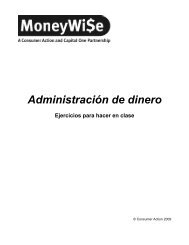

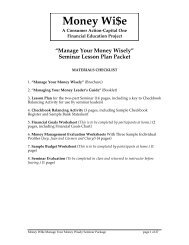
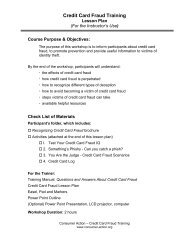

![Debt Collection Issue [Winter 2007-2008] - Consumer Action](https://img.yumpu.com/43405069/1/169x260/debt-collection-issue-winter-2007-2008-consumer-action.jpg?quality=85)
